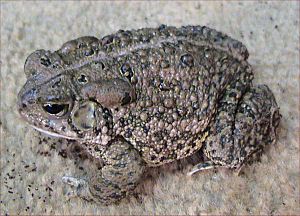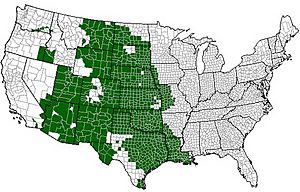Woodhouse's toad facts for kids
Quick facts for kids Woodhouse's toad |
|
|---|---|
 |
|
| Conservation status | |
| Scientific classification | |
 |
|
| United States range of A. woodhousii | |
| Synonyms | |
|
Bufo woodhousii Girard, 1854 |
The Woodhouse's toad (Anaxyrus woodhousii) is a medium-sized toad found in the United States and Mexico. It can grow to about 4 inches (10 cm) long. This toad is a "true toad," meaning it belongs to the Bufonidae family. Sometimes, Woodhouse's toads can even mix with American toads where their living areas overlap.
Contents
How Scientists Name Toads
In 1854, a French scientist named Charles Frédéric Girard first described the Woodhouse's toad. He named it Bufo woodhousii to honor an American doctor and naturalist, Samuel Washington Woodhouse.
Later, in 2006, scientists changed how they grouped many toads. The large group called Bufo was split up. North American toads, including the Woodhouse's toad, were moved into a new group called Anaxyrus. That's why its scientific name is now A. woodhousii.
There are three main types, or subspecies, of Woodhouse's toad:
- Rocky Mountain toad – Anaxyrus woodhousii woodhousii
- East Texas toad – Anaxyrus woodhousii velatus
- Southwestern Woodhouse's toad – Anaxyrus woodhousii australis
For a while, the Fowler's toad was thought to be a subspecies of Woodhouse's toad.
What Woodhouse's Toads Look Like
Woodhouse's toads are strong, sturdy amphibians. They can grow up to 5 inches (12.7 cm) long from their snout to their rear end. Their heads have noticeable ridges, called cranial crests, located in front of and between their eyes.
Behind their eyes, they have long, large glands called parotoid glands. The toad's back is usually grayish-brown or yellowish-brown. It has many small dark spots. A thin, light-colored line often runs down its back along its spine. Its belly is lighter and usually doesn't have spots.
Male Woodhouse's toads have a single vocal sac on their throat. When they call, it sounds like a sheep's bleat and lasts for one to three seconds.
Where Woodhouse's Toads Live
Woodhouse's toads live in North America, from Mexico in the south all the way to Washington state in the north. They can be found at high places, up to about 8,200 feet (2,500 meters) above sea level.
In the United States, you can find them in many states, including Arizona, California, Colorado, Idaho, Kansas, Montana, Nebraska, Nevada, New Mexico, North Dakota, Oklahoma, Oregon, South Dakota, Texas, Utah, Washington, and Wyoming.
These toads like to live near water. In western areas, they often live in wooded areas next to streams and rivers. In higher places, they prefer wet meadows, ponds, and lakes. They can also live in cities, canals, and farm fields that are watered.

What Woodhouse's Toads Do
Woodhouse's toads are nocturnal, meaning they are most active at night. They eat insects and other small invertebrates (animals without backbones). If you live near them, you might see these toads gathered under outdoor lights. They do this to catch the insects that are attracted to the light.
Reproduction and Life Cycle
Woodhouse's toads breed at different times of the year, depending on where they live. The male toads call out from inside or near standing water. The female toads lay their eggs in long, jelly-like strings. They lay these eggs in calm water, like ditches, ponds, pools, cattle tanks, and lakes.
The baby toads, called tadpoles, usually take about five to eight weeks to grow. After this time, they go through metamorphosis, changing from tadpoles into small toads.
Conservation Status
The Woodhouse's toad lives across a very large area. Scientists believe there are many of them in total. They can live in many different types of places and can even handle some changes to their homes. The number of Woodhouse's toads seems to be stable. No major threats have been found for them.
Because of this, the International Union for the Conservation of Nature (IUCN) says the Woodhouse's toad is of "Least Concern". This means they are not currently at risk of disappearing. However, in central Arizona, it seems that Woodhouse's toads might be taking over areas where the Arizona toad (Anaxyrus microscaphus) used to live.
- Woodhouse's toad at the Encyclopedia of Life
- Anaxyrus woodhousii in the CalPhotos Photo Database, University of California, Berkeley
See also
 In Spanish: Sapo de Woodhouse para niños
In Spanish: Sapo de Woodhouse para niños


